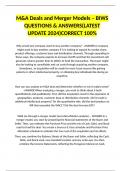M&A Deals and Merger Models – BIWS
QUESTIONS & ANSWERS(LATEST
UPDATE 2024)CORRECT 100%
Why would one company want to buy another company? - ANSWER A company
might want to buy another company if it is looking to expand its market share,
product offerings, customer base and distribution channels. Through expanding in
these ways, the company expects to increase its EPS and that the investment will
generate returns greater than its WACC to fund the transaction. The buyer might
also be looking to consolidate and cut costs through acquiring another company.
Sometimes, an acquisition will be made for more fuzzy reasons like gaining
patents or other intellectual property, or obtaining key individuals like during an
acquihire.
How can you analyze an M&A deal and determine whether or not it makes sense?
- ANSWER When analyzing a merger, you want to think about it both
quantitatively and qualitatively. First, did the acquisition result in the expansion of
geographies, products, customer base or distribution channels. Did it result in
additional intellectual property? On the quantitative side, did the deal produce an
IRR that exceeded the WACC? Did the deal increase EPS?
Walk me through a merger model (accretion/dilution analysis). - ANSWER In a
merger model, you start by projecting the financial statements of the Buyer and
Seller. Then, you estimate the Purchase Price and the mix of Cash, Debt, and Stock
used to fund the deal. You create a Sources & Uses schedule and Purchase Price
Allocation schedule to estimate the true cost of the acquisition and its effects.
Then, you combine the Balance Sheets of the Buyer and Seller, reflecting the Cash,
Debt, and Stock used, new Goodwill created, and any write-ups. You then
combine the Income Statements, reflecting the Foregone Interest on Cash,
, Interest on Debt, and synergies. If Debt or Cash changes over time, your Interest
figures should also change.
The Combined Net Income equals the Combined Pre-Tax Income times (1 - Buyer's
Tax Rate), and to get the Combined EPS, you divide that by the Buyer's Existing
Share Count + New Shares Issued in the Deal.
You calculate the accretion/dilution by taking the Combined EPS, dividing it by the
Buyer's standalone EPS, and subtracting 1.
Why might an M&A deal be accretive or dilutive? - ANSWER A deal will be
accretive if the cost of acquisition is less than the seller's yield OR in absolute
terms, if the pre-tax income from a seller exceeds that cost of acquisition.
How can you tell whether an M&A deal will be accretive or dilutive? - ANSWER
You compare the Weighted Cost of Acquisition to the Seller's Yield at its purchase
price. • Cost of Cash = Foregone Interest Rate on Cash * (1 - Buyer's Tax Rate) •
Cost of Debt = Interest Rate on New Debt * (1 - Buyer's Tax Rate) • Cost of Stock =
Reciprocal of the Buyer's P / E multiple, i.e. Net Income / Equity Value. • Seller's
Yield = Reciprocal of the Seller's P / E multiple, calculated using the Purchase
Equity Value. Weighted Cost of Acquisition = % Cash Used * Cost of Cash + % Debt
Used * Cost of Debt + % Stock Used * Cost of Stock. If the Weighted Cost is less
than the Seller's Yield, the deal will be accretive, if the Weighted Cost is greater
than the Seller's Yield, the deal will be dilutive.
Why do you focus so much on EPS in M&A deals? - ANSWER EPS is the only metric
that captures the full impact of the deal, including the foregone interest rate on
cash, the additional interest rate on issued debt, and the additional shares issued.
How do you determine the Purchase Price in an M&A deal? - ANSWER Well it
depends on whether the company is public or private. if the company is PUBLIC,
, you assume that the purchase price will equal a premium over the current share
price. If the company is PRIVATE, you use standard valuation methodologies.
What are the advantages and disadvantages of each purchase method (Cash,
Debt, and Stock) in M&A deals? - ANSWER Cash is usually the cheapest option
because foregone interest rates on cash are typically 1-3%. However, Cash is taxed
immediately. Debt is more expensive than cash, less expensive than stock. This is
because interest rates on debt is higher than foregone interest on cash, but it is
tax deductible and less risky. Stock will typically be the most expensive purchase
method because it involves giving up ownership, however if the PE multiple is
high, then it may be a cheaper option. Additionally, when you pay in stock, the
seller has a stake in the success of the deal and it will not pay out taxes
immediately.
How does an Acquirer determine the mix of Cash, Debt, and Stock to use in a
deal? - ANSWER Since cash is usually the cheapest option, you might assume that
the seller will MAX out cash while still preserving the minimum cash balance.
Then might max out debt while still preserving the debt/ebitda and
ebitda/interest ratios. Then, if more funding is needed, the remaining will be
funded by stock
Which purchase method does a Seller prefer in an M&A deal? - ANSWER To the
seller, debt and cash are similar. They are both paid out in cash immediately and
the payment is taxed immediately. Additionally, they involve no participation in
the upside. To the seller, stock means participate in the upside, no immediate
payment in cash, and the potential that the stock price could drop and the value
of the deal will depreciate.
Third, merger models don't capture the risk inherent in M&A deals. 100% Cash
deals almost always look accretive, even though the integration process might go
wrong, legal issues might arise, and customers or shareholders might revolt.




